Articles
- Page Path
- HOME > Res Vestib Sci > Volume 17(4); 2018 > Article
-
Original Article
마우스 공간지각과 기억 형성에 미치는 전정 유래 정보의 규명 -
한규철1, 김민범2, 김미주2

- Identification of Vestibular Organ Originated Information on Spatial Memory in Mice
-
Gyu Cheol Han1, Minbum Kim2, Mi Joo Kim2

-
Research in Vestibular Science 2018;17(4):134-141.
DOI: https://doi.org/10.21790/rvs.2018.17.4.134
Published online: December 21, 2018
1Department of Otolaryngology-Head and Neck Surgery, Gachon University of Medicine and Science, Graduate School of Medicine, Incheon, Korea
2Department of Otorhinolaryngology-Head and Neck Surgery, Catholic Kwandong University, International St. Mary’s Hospital, Incheon, Korea
- Corresponding Author: Mi Joo Kim Department of Otolaryngology-Head and Neck Surgery, Catholic Kwandong University of Medicine and Science, International St. Mary’s Hospital, Simgok-ro 100gil 25, Seo-gu, Incheon 22711, Korea Tel: +82-32-290-3056 Fax: +82-32-290-3055 E-mail: mijookimmd@gmail.com
• Received: November 5, 2018 • Revised: December 1, 2018 • Accepted: December 2, 2018
Copyright © 2018 by The Korean Balance Society. All rights reserved.
This is an open access article distributed under the terms of the Creative Commons Attribution Non-Commercial License (http://creativecommons.org/licenses/by-nc/4.0) which permits unrestricted non-commercial use, distribution, and reproduction in any medium, provided the original work is properly cited.
- 5,932 Views
- 83 Download
- 2 Crossref
Abstract
-
Objectives
- We aimed to study the role of vestibular input on spatial memory performance in mice that had undergone bilateral surgical labyrinthectomy, semicircular canal (SCC) occlusion and 4G hypergravity exposure.
-
Methods
- Twelve to 16 weeks old ICR mice (n=30) were used for the experiment. The experimental group divided into 3 groups. One group had undergone bilateral chemical labyrinthectomy, and the other group had performed SCC occlusion surgery, and the last group was exposed to 4G hypergravity for 2 weeks. The movement of mice was recorded using camera in Y maze which had 3 radial arms (35 cm long, 7 cm high, 10 cm wide). We counted the number of visiting arms and analyzed the information of arm selection using program we developed before and after procedure.
-
Results
- The bilateral labyrinthectomy group which semicircular canal and otolithic function was impaired showed low behavioral performance and spacial memory. The semicircular canal occlusion with CO2 laser group which only semicircular canal function was impaired showed no difference in performance activity and spatial memory. However the hypergravity exposure group in which only otolithic function impaired showed spatial memory function was affected but the behavioral performance was spared. The impairment of spatial memory recovered after a few days after exposure in hypergravity group.
-
Conclusions
- This spatial memory function was affected by bilateral vestibular loss. Space-related information processing seems to be determined by otolithic organ information rather than semicircular canals. Due to otolithic function impairment, spatial learning was impaired after exposure to gravity changes in animals and this impaired performance was compensated after normal gravity exposure.
서 론
대상 및 방법
결 과
고 찰
결 론
Acknowledgments
Fig. 1.Centrifugal rotator for hypergravity (HG). Animals were exposed to HG in a centrifuge with 4 horizontal arms (length, 0.8 m) and ventilated free-swinging gondolas situated at the end of the arms. Each gondola contained one cages (0.3 m long, 0.4 m high, 0.3 m wide). The HG vector was perpendicular to the bottom of the cages and had a magnitude of 4G (angular velocity, 3.18 rad/sec; tilt of the gondolas, 0.578°). The mice were rotated in animal rotator for 22 hours a day and rested during stop of rotation in 1G for 2 weeks. A camera in each gondola allowed observation of the animals. Cages were cleaned every day and turned clockwisely.
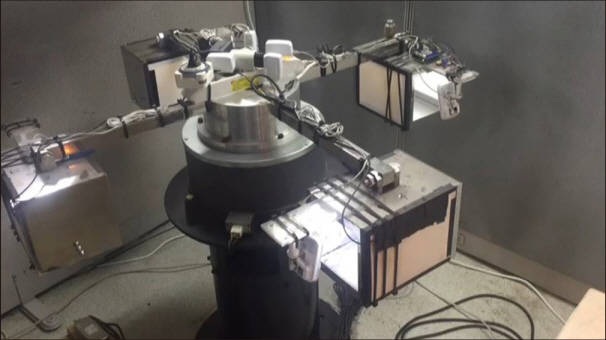

Fig. 2.Y-maze and analyzing program. The Y-maze consisted of symmetrical 3 arms (35 cm long, 7 cm, high, 10 cm wide). The performance was evaluated by spontaneous alteration test: the number of visit each arms & 2. Place recognition test. The movement of mouse was recorded on the camera fixed to top of the maze. We developed the program to analyze the movement of mouse in Y-maze. The total number of ABC arm entries and alternation behavior were recorded using a video camera and the program.
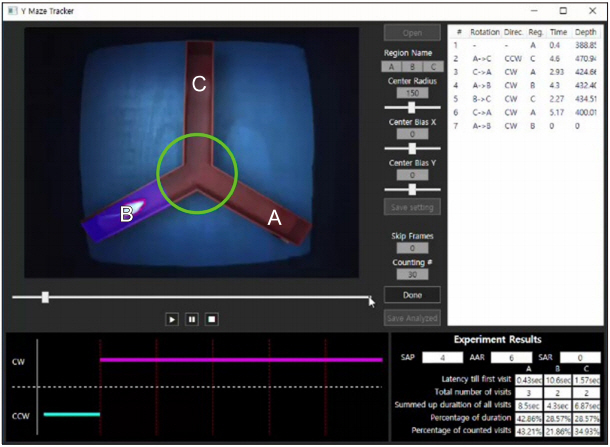

Fig. 3.Place recognition test. Spatial memory was assessed by place recognition test. The task consisted of 2 steps. Mouse was placed and allowed to explore the maze in which B arm blocked so the mouse could explore only A and C arm for space memory training for 3 minutes. After the training time, the mouse was placed in the maze with the 3 arms open and was allowed to explore the maze freely for 6 minutes. If the mouse is normal spatial perception, the mouse should visit B new arm more because mouse has affinity to new place.
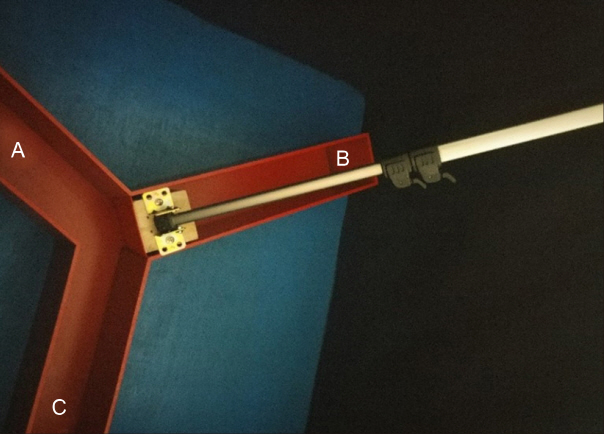

Fig. 4.Results of Y-maze test in bilateral labyrinthectomy group. The number of spontaneous alteration performance (SAP), and alternative arm return (AAR) diminished statistically in the bilateral labyrinthectomy group compared to control group. The same arm return (SAR) results showed the number increased postoperatively. The percentage of B arm visiting rate in the bilateral labyrinthectomy group was lower than in the control group in place recognition test (PRT). The changes in the 3rd postoperative day in the all Y-maze tests were not recovered until 10 days after labyrinthectomy. POD, postoperative day.
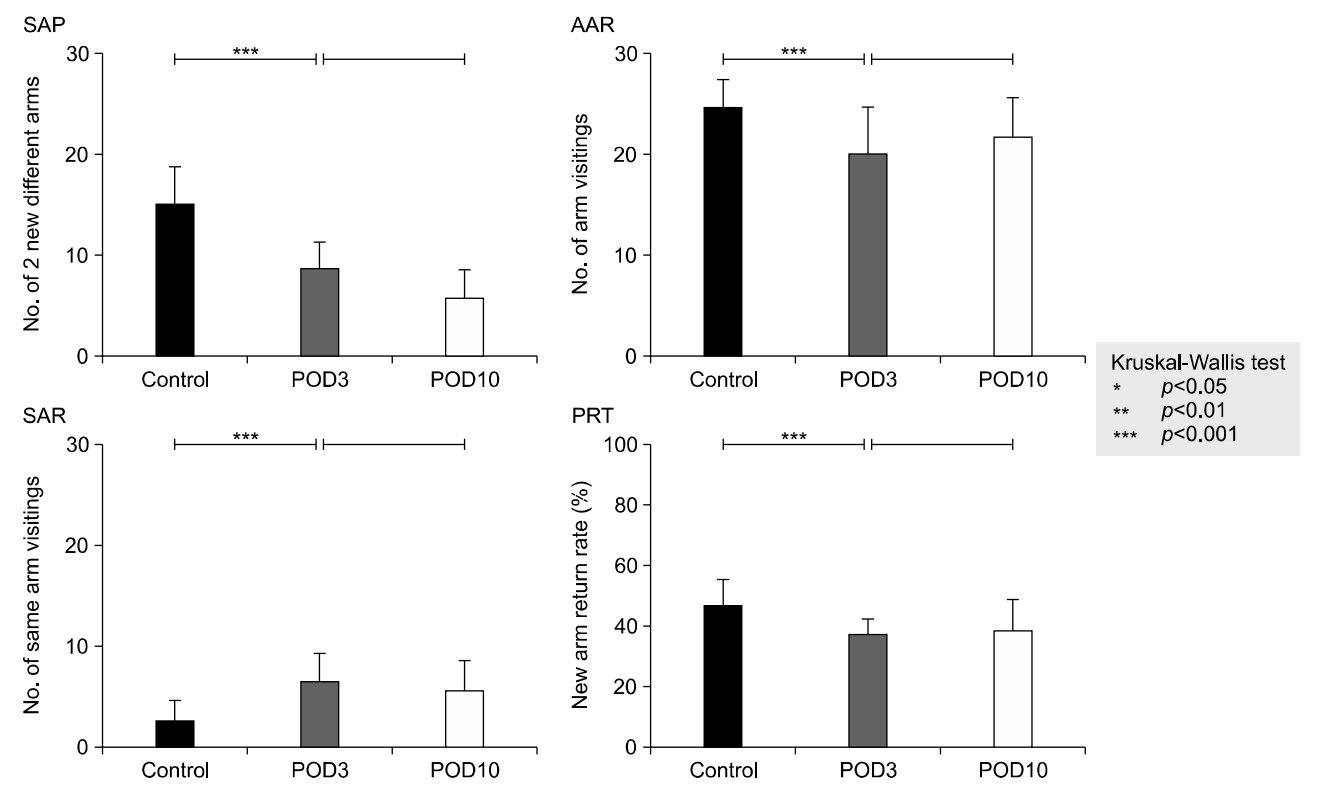

Fig. 5.Results of Y-maze test in semicircular canal occlusion group. The semicircular canal occlusion group showed no impairment in both spontaneous alternation test and place recognition test compared to control group in the day of postoperative 7th and 14th day. SAP, spontaneous alteration performance; AAR, alternative arm return; SAR, same arm return; PRT, place recognition test; LO, laser occlusion; POD, postoperative day.
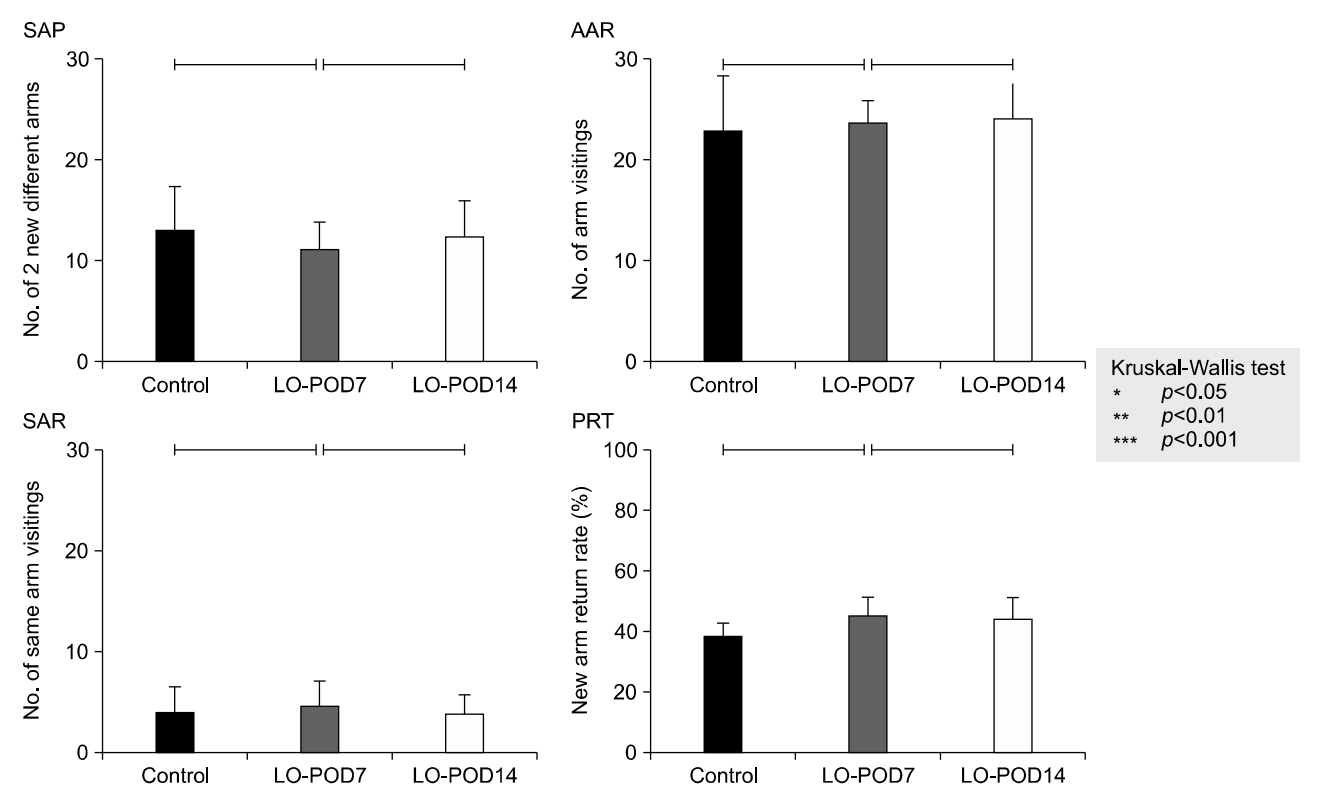

Fig. 6.Results of Y-maze test in 4G hypergravity group. The 4G hypergravity exposure group showed statistical impairment of spatial perception & memory in SAP and AAR test and place recognition test. However, the score of SAR between hypergravity group and control group had no statistical difference. The spatial performance was gradually recovered after the mouse came back to normal gravity. SAP, spontaneous alteration performance; AAR, alternative arm return; SAR, same arm return; PRT, place recognition test.
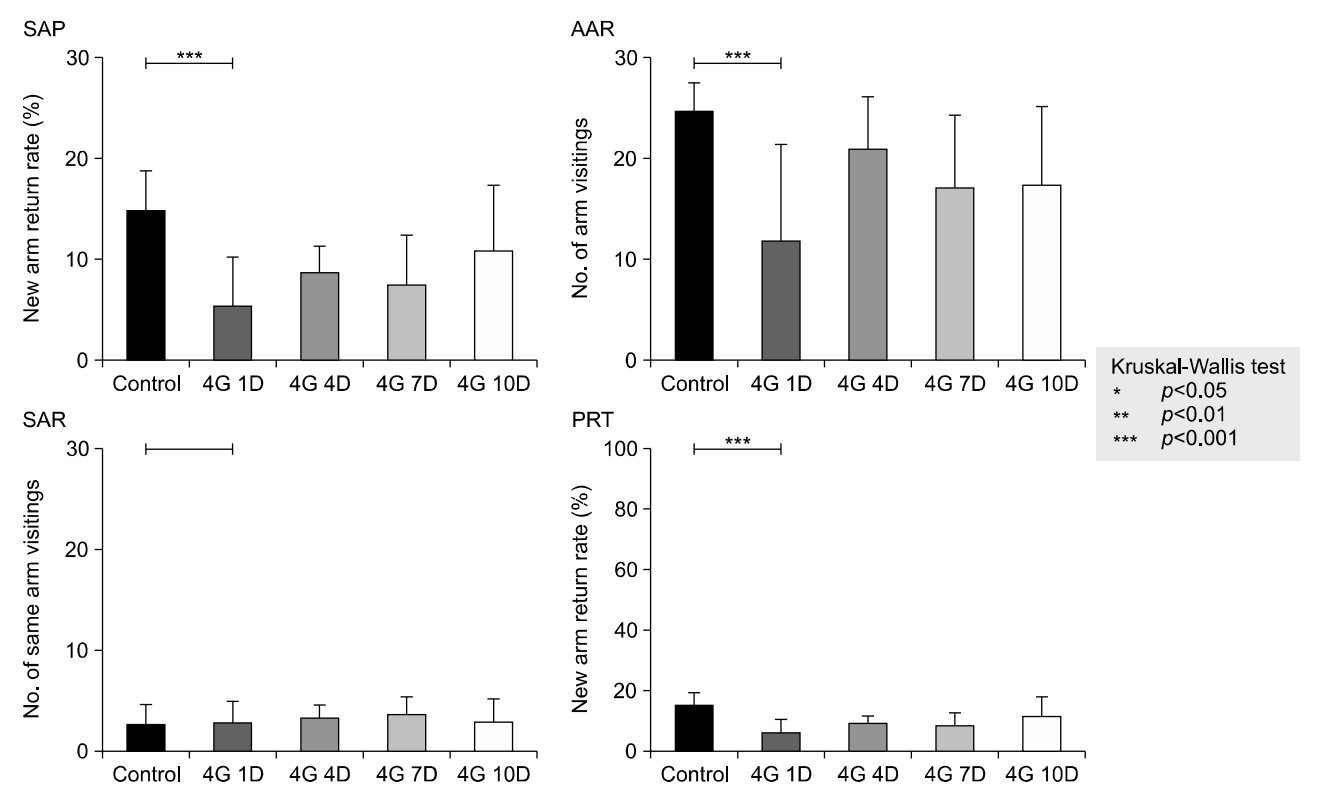

- 1. Sondag HN, de Jong HA, Oosterveld WJ. Altered behaviour in hamsters conceived and born in hypergravity. Brain Res Bull 1997;43:289–94.ArticlePubMed
- 2. Ronca AE, Alberts JR. Effects of prenatal spaceflight on vestibular responses in neonatal rats. J Appl Physiol (1985) 2000;89:2318–24.ArticlePubMed
- 3. Bouët V, Gahéry Y, Lacour M. Behavioural changes induced by early and long-term gravito-inertial force modification in the rat. Behav Brain Res 2003;139:97–104.ArticlePubMed
- 4. Besnard S, Machado ML, Vignaux G, Boulouard M, Coquerel A, Bouet V, et al. Influence of vestibular input on spatial and nonspatial memory and on hippocampal NMDA receptors. Hippocampus 2012;22:814–26.ArticlePubMed
- 5. Ventre-Dominey J, Nighoghossian N, Denise P. Interaction between cortical control of vestibular function and spatial representation in man. Ann N Y Acad Sci 2005;1039:494–7.ArticlePubMed
- 6. Stackman RW, Taube JS. Firing properties of head direction cells in the rat anterior thalamic nucleus: dependence on vestibular input. J Neurosci 1997;17:4349–58.ArticlePubMedPMC
- 7. Bouët V, Wubbels RJ, de Jong HA, Gramsbergen A. Behavioural consequences of hypergravity in developing rats. Brain Res Dev Brain Res 2004;153:69–78.ArticlePubMed
- 8. Gaboyard S, Sans A, Lehouelleur J. Differential impact of hypergravity on maturating innervation in vestibular epithelia during rat development. Brain Res Dev Brain Res 2003;143:15–23.ArticlePubMed
- 9. Jamon M. The development of vestibular system and related functions in mammals: impact of gravity. Front Integr Neurosci 2014;8:11. ArticlePubMedPMC
- 10. Machado ML, Kroichvili N, Freret T, Philoxène B, Lelong-Boulouard V, Denise P, et al. Spatial and non-spatial performance in mutant mice devoid of otoliths. Neurosci Lett 2012;522:57–61.ArticlePubMed
- 11. Pfeiffer C, Serino A, Blanke O. The vestibular system: a spatial reference for bodily self-consciousness. Front Integr Neurosci 2014;8:31. ArticlePubMedPMC
- 12. Gabriel M, Frippiat JP, Frey H, Horn ER. The sensitivity of an immature vestibular system to altered gravity. J Exp Zool A Ecol Genet Physiol 2012;317:333–46.ArticlePubMed
- 13. Curthoys IS, Halmagyi GM. Vestibular compensation: a review of the oculomotor, neural, and clinical consequences of unilateral vestibular loss. J Vestib Res 1995;5:67–107.ArticlePubMed
- 14. de Caprona MD, Beisel KW, Nichols DH, Fritzsch B. Partial behavioral compensation is revealed in balance tasked mutant mice lacking otoconia. Brain Res Bull 2004;64:289–301.ArticlePubMed
- 15. Brandt T, Schautzer F, Hamilton DA, Brüning R, Markowitsch HJ, Kalla R, et al. Vestibular loss causes hippocampal atrophy and impaired spatial memory in humans. Brain 2005;128(Pt 11):2732–41.ArticlePubMedPDF
- 16. Mandillo S, Del Signore A, Paggi P, Francia N, Santucci D, Mele A, et al. Effects of acute and repeated daily exposure to hypergravity on spatial learning in mice. Neurosci Lett 2003;336:147–50.ArticlePubMed
- 17. Horii A, Russell NA, Smith PF, Darlington CL, Bilkey DK. Vestibular influences on CA1 neurons in the rat hippocampus: an electrophysiological study in vivo. Exp Brain Res 2004;155:245–50.ArticlePubMed
- 18. Blair HT, Sharp PE. Visual and vestibular influences on head-direction cells in the anterior thalamus of the rat. Behav Neurosci 1996;110:643–60.ArticlePubMedPDF
REFERENCES
Figure & Data
References
Citations
Citations to this article as recorded by 

- Galvanic Vestibular Stimulation Improves Spatial Cognition After Unilateral Labyrinthectomy in Mice
Thanh Tin Nguyen, Gi-Sung Nam, Jin-Ju Kang, Gyu Cheol Han, Ji-Soo Kim, Marianne Dieterich, Sun-Young Oh
Frontiers in Neurology.2021;[Epub] CrossRef - The Differential Effects of Acute Right- vs. Left-Sided Vestibular Deafferentation on Spatial Cognition in Unilateral Labyrinthectomized Mice
Thanh Tin Nguyen, Gi-Sung Nam, Jin-Ju Kang, Gyu Cheol Han, Ji-Soo Kim, Marianne Dieterich, Sun-Young Oh
Frontiers in Neurology.2021;[Epub] CrossRef

 KBS
KBS
 PubReader
PubReader ePub Link
ePub Link Cite
Cite







